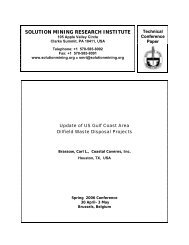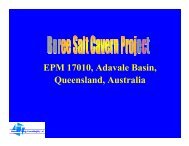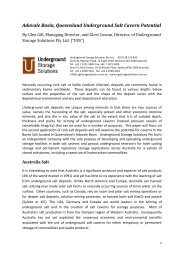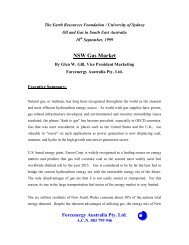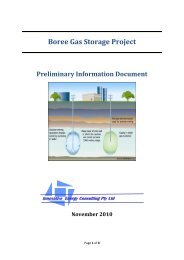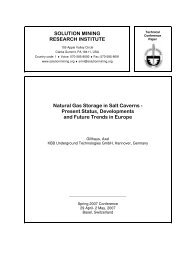Mining Journal - Innovative Energy Consulting - Brisbane, Australia
Mining Journal - Innovative Energy Consulting - Brisbane, Australia
Mining Journal - Innovative Energy Consulting - Brisbane, Australia
Create successful ePaper yourself
Turn your PDF publications into a flip-book with our unique Google optimized e-Paper software.
are near zero, so stored gas cannot escape. Salt caverns provide high<br />
deliverability; gas can be withdrawn quickly because there is no pressure loss<br />
from flow through pores. Cavern storage can cycle – switch from injection to<br />
production – in a matter of minutes, and contains a large fraction of working gas<br />
relative to total gas. Salt caverns are the preferred option for merchant storage,<br />
because they allow frequent cycling and high rates of injection and production. 2<br />
Caverns are located in salt formations which ideally are as homogenous as possible and<br />
which are very thick (e.g. thick bedded salt, salt pillow, salt dome) although there are many<br />
caverns in thin and more or less impure evaporite sequences (e. g. thin bedded salt, salt in<br />
tectonic nappes). 3 Domal salt cavern storage is far superior to bedded salt cavern storage<br />
but the domal salt deposits are much rarer than bedded salt. Consequently countries with<br />
domal salt deposits at depths below ground level from 400 m to 2,000 m are fortunate since<br />
the benefits of domal salt cavern underground storage having numerous applications are<br />
well documented and appreciated.<br />
Salt Caverns basically constitute very large underground openings that<br />
provide secure containment for materials that do not dissolve salt. In<br />
general, uses of salt caverns can be classified as either storage or disposal<br />
operations. Storage of liquid and gaseous hydrocarbons, and associated<br />
products, was successful early on, and remains the main use of salt caverns<br />
today. Disposal of wastes and “by-product” constitutes the next most<br />
important use of salt caverns. 4<br />
Salt caverns are solution mined via wells drilled into salt formations (bedded salts or salt<br />
domes) of sufficient thicknesses at depths of up to 2,000 m below ground level. Cavern<br />
dimensions can be up to 600 m in height and 60 to 100 m in diameter. Salt cavern volumes<br />
are larger for liquid storage than for gas storage and are generally in a range of between<br />
500,000 to 800,000 m³. A 10:1 ratio of height to span is considered to be optimal. The<br />
design and leaching of salt caverns to create a high quality underground pressure vessel is<br />
well established and is considerably less complex in dome salt formations compared to<br />
bedded salt formations. The supply of water for leaching and the disposal of the resultant<br />
brine often present a challenge, for the total quality of water required to leach a cavern in a<br />
salt formation is 7 to 10 times the cavern volume. The operation of salt cavern storage for a<br />
variety of storage purposes and cycling conditions has evolved over the past 50 years to that<br />
of an extremely safe and environmentally benign nature.<br />
The following figure 2.0 illustrates the known salt deposits worldwide and distinguishes<br />
between bedded and the higher value domal salt deposits.<br />
2 Numerous authors from around the world, Oilfield Review article, “Storing Natural Gas Underground”,<br />
Summer 2002, page 4.<br />
3 A Gillhaus and P. Horvath, KBB Underground Technologies, Solution <strong>Mining</strong> Research Institute Research<br />
Project No. 2007-1-SMRI: “Compilation of geological and geotechnical data of worldwide domal salt deposits<br />
and domal salt cavern fields”, page 21.<br />
4 R. L. Thomas and R. M. Gehle, AGM Inc., “A Brief History of Salt Cavern Use”, page 2.<br />
4




